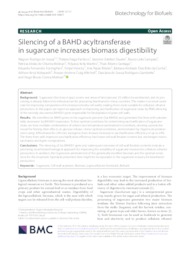Silencing of a BAHD acyltransferase in sugarcane increases biomass digestibility.
Silencing of a BAHD acyltransferase in sugarcane increases biomass digestibility.
Autoria: SOUZA, W. R. de; PACHECO, T. F.; DUARTE, K. E.; SAMPAIO, B. L.; OLIVEIRA, P. A. de; MARTINS, P. M.; SANTIAGO, T. R.; FORMIGHIERI, E. F.; VINECKY, F.; RIBEIRO, A. P.; DIAS, B. B. A.; KOBAYASHI, A. K.; MITCHELL, R. A. C.; RODRIGUES, D. de S.; MOLINARI, H. B. C.
Resumo: Background: Sugarcane (Saccharum spp.) covers vast areas of land (around 25 million ha worldwide), and its processing is already linked into infrastructure for producing bioethanol in many countries. This makes it an ideal candidate for improving composition of its residues (mostly cell walls), making them more suitable for cellulosic ethanol production. In this paper, we report an approach to improving saccharification of sugarcane straw by RNAi silencing of the recently discovered BAHD01 gene responsible for feruloylation of grass cell walls. Results: We identified six BAHD genes in the sugarcane genome (SacBAHDs) and generated five lines with substantially decreased SacBAHD01 expression. To find optimal conditions for determining saccharification of sugarcane straw, we tried multiple combinations of solvent and temperature pretreatment conditions, devising a predictive model for finding their effects on glucose release. Under optimal conditions, demonstrated by Organosolv pretreatment using 30% ethanol for 240 min, transgenic lines showed increases in saccharification efficiency of up to 24%. The three lines with improved saccharification efficiency had lower cell-wall ferulate content but unchanged monosaccharide and lignin compositions. Conclusions: The silencing of SacBAHD01 gene and subsequent decrease of cell-wall ferulate contents indicate a promising novel biotechnological approach for improving the suitability of sugarcane residues for cellulosic ethanol production. In addition, the Organosolv pretreatment of the genetically modified biomass and the optimal conditions for the enzymatic hydrolysis presented here might be incorporated in the sugarcane industry for bioethanol production. Keywords: Sugarcane,
Ano de publicação: 2019
Tipo de publicação: Artigo de periódico
Unidade: Embrapa Agroenergia
Palavras-chave: Cell-wall acylation, Lignocellulosic feedstock
Observações
1 - Por padrão são exibidas publicações dos últimos 20 anos. Para encontrar publicações mais antigas, configure o filtro ano de publicação, colocando o ano a partir do qual você deseja encontrar publicações. O filtro está na coluna da esquerda na busca acima.
2 - Para ler algumas publicações da Embrapa (apenas as que estão em formato ePub), é necessário ter, no celular ou computador, um desses softwares gratuitos. Sistemas Android: Google Play Livros; IOS: iBooks; Windows e Linux: software Calibre.
Acesse outras publicações
Acesse a Base de Dados da Pesquisa Agropecuária (BDPA) para consultar o acervo completo das bibliotecas da Embrapa.

